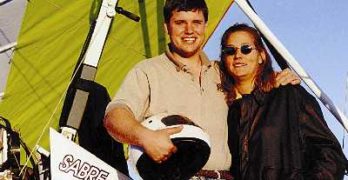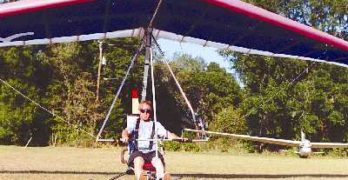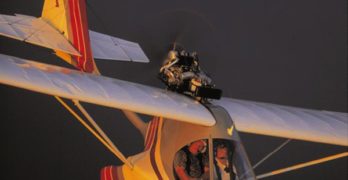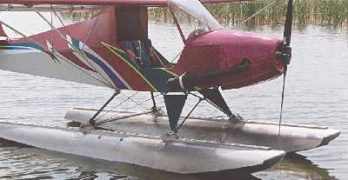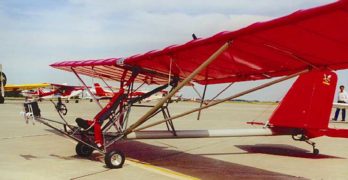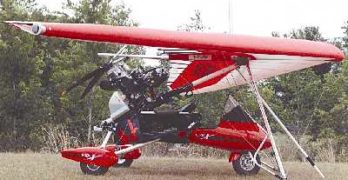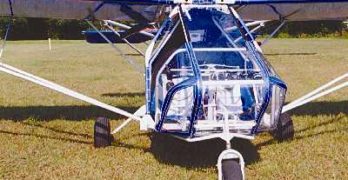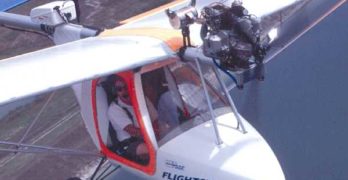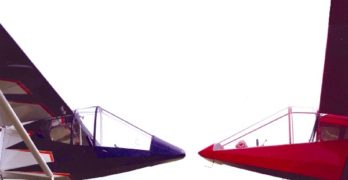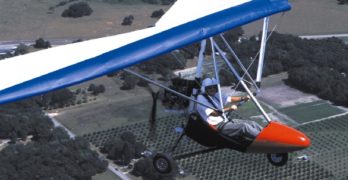Only a little more than 10 years ago, the wall fell in Berlin, Germany and Communism collapsed in the USSR. Before these momentous events, few Americans knew anything about the Ukraine (which was part of the USSR) and even those who did were largely unaware of its ability to produce aircraft.
Yet by the mid-1990s, some Americans became aware of a Ukrainian company named Aeros. One man became an importer of their hang glider line. G.W. Meadows and his Thermal Riding Vehicles business sold so many hang gliders from the former Soviet satellite that the American market leader, Wills Wing, had to drop prices to remain competitive with the lower cost hang gliders from eastern Europe.
In this article I’ll review the Venture, the newest Aeros model for the American ultralight market. But this new Aeros ultralight follows the Aeros Antares (once known as Graffiti), reviewed in the December 1997 issue of Ultralight Flying!
Search Results for : Electric
Not finding exactly what you expected? Try our advanced search option.
Select a manufacturer to go straight to all our content about that manufacturer.
Select an aircraft model to go straight to all our content about that model.
Sky Cycle
In a world of ultralights populated with powered parachutes, powered paragliders, weight-shift trikes, and all manner of 3-axis ultralights, why not a powered hang glider? Why not return to our roots?
For those too new to the scene to remember, ultralights started out as powered hang gliders. John Moody, the man widely known as the “Father of Ultralights,” first motorized and flew a hang glider called the Icarus II (which evolved into the Easy Riser). Moody’s first ultralight, back in the mid-1970s, had no landing gear and no tail because those appendages weren’t on hang gliders then, or now.
After Moody’s early work – plus that of others in the hang gliding and ultralight community – other pioneers began adding power packages to more conventional hang gliders. The Easy Riser Moody flew had good performance but didn’t break down as efficiently as the fully-foldable “flex wings,” as they are commonly known today.
Interplane Skyboy
In May 2000 I wrote about the imported Sabre Aircraft Venture trike. That model from the Ukraine was quite impressive and worthy of your consideration. Now from the Czech Republic comes the Interplane Skyboy. Should Yankee ultralight manufacturers show concern? Yes, I’d say so. However, American pilots – while perhaps showing an interest in imported designs – don’t seem to buy a lot of these planes. Or do they?
In recent years we’ve seen trike sales soar. Few industry leaders predicted this despite the persistent efforts of the big European trike builders. Many veterans claimed trikes would never have an impact on the majority of pilots who prefer 3-axis controls. They are being proved wrong, for now anyway.
A key reason that holds back U.S. purchases of imported aircraft has to do with local support. Even a good importer can’t always control when spare parts are available. Interplane solves this dilemma in an interesting way and with American style: they bought the Czech Republic factory.
Flying Sky Raider
Since Flying K Enterprises’ Sky Raider arrived on the scene 4 years ago, the ultralight design has achieved excellent success in the market selling more than 140 kits (not including the 65 or so fuselages shipped to SkyStar Aircraft which they use for their Kitfox Lite). However, the company behind the Sky Raider design has suffered in nontechnical ways.
Original Flying K principals brothers Ken and Stace Schraeder split up and started separate companies making ultralights. Then, only months after the split, Ken Schraeder was killed while flying a Sky Raider (see “Flightlines – Kenny Schraeder Killed in Crash,” April ’00 Ultralight Flying! magazine).
Despite these setbacks, the Sky Raider flies onward. In fact, Flying K Enterprises seems to be healthy and energetic despite the twin losses.
When the company shows their Sky Raider floatplane model and an example of their coming 2-seater, crowds often flock around the ultralights. I was full of anticipation to see how the floatplane would fly.
Rans Stinger
The original concept and final design Stinger appear to share only two things. First is the name – S-17 Stinger – and the second is the little bumblebee logo. In every other case I could discern, the finished Stinger is a totally new design from Randy Schlitter’s original idea.
Stinger version two flew for the first time on September 10, 1999. Barely a week later, I found myself aloft in the new ultralight. Normally, I’m not anxious to jump into a manufacturer’s brand-new design. I much prefer waiting until they have the design fully worked out.
However, Randy Schlitter has an excellent reputation for airplanes that seem to fly right off the drawing board (or out of the CAD program these days). He’d put some hours on the Stinger and had given it his blessing. I observed him fly it first and by all measures, it appeared to be ready for evaluation flying.
Airborne Streak
I am amazed. I didn’t think AirBorne Australia could do it, but they made their top-of-the-line wing called the Streak 2000 handle dramatically better than previous iterations.
Published in Light Sport and Ultralight Flying
Seating
2, tandem
Empty weight
476 pounds
Gross weight
992 pounds
Wingspan
32.4 feet
Wing area
167 square feet
Wing loading
6.2 pounds per square foot
Length
11.3 feet
Height
11.5 feet
Fuel Capacity
18.5 gallons
Kit type
Fully assembled
Airworthiness
Certified SLSA
Build time
Minor assembly from shipping container
Standard engine
Rotax 5821 or 9122
Power
66 hp at 6,500 rpm
Power loading
12.4 pounds per hp
Cruise speed
(middle hole) 45-60 mph (forward hole) 75 mph
Stall Speed
39 mph
Never exceed speed
93 mph
Rate of climb at gross
770 fpm
Takeoff distance at gross
590 feet
Landing distance at gross
575 feet
Range (powered)
350 miles
Fuel Consumption
3.3 gph
Notes:
1also available with the Rotax 503 engine (2000 Article).2Rotax 512 UL (2006 Article).
Golden Circles
As with many ultralight aircraft brands, when single-seaters become dual machines the machine gets heavier and more complicated. And when ultralights get heavier, they often don’t work quite the same.
Since flight school operators and pilots wanting to carry a friend request 2-seat capability, ultralight manufacturers respond, trying to get as close as possible to single-seater feel. But this isn’t simple. Two-seat ultralights often give up some of the qualities that make a single-seater pure joy to fly.
However, designers make constant refinements in ultralights.
Look around at airshows. Most of the ultralights on display these days are well-built machines with lots of custom hardware. Nearly every one got that good employing the CANI approach – Constant And Never-ending Improvement.
Golden Circle’s T-Bird II is one model that has seen subtle but noticeable improvements that make the breed better. Even to those intimate with the Iowa ultralight producer, these changes may evade your inspection.
Flightstar II Sport Cabin
In August 1999,Ultralight Flying! reported on the Flightstar II SL. Thirteen months later, another report is needed as, once again, Tom Peghiny and Spark Lamontagne have upgraded their principal selling model.
Flightstar is the name of the plane and Flightstar Sportplanes is the name of the company, and “refinement” ought to be permanently attached. I’ve followed many ultralights over many years. Some have changed a lot, some have seen almost no change. The Flightstar has almost constantly evolved.
Why change this successful design? After all, it costs money to design, test and build new parts inventories. It takes time and more money to update assembly manuals. Why do all this if the ultralight is doing well? The reason is simple: to make a better product that more people will buy. At least the answer sounds simple; in fact, it may be surprisingly complicated to achieve.
Before we get into how the ultralight flies, let’s review what makes this Flightstar II SC (Sport Cabin) different from the Flightstar II SL (Sport Light).
New Kolbra ULT
For ultralight enthusiasts, the focus of this pilot report is on the Kolbra model that I flew in late summer 2000, fitted with the 66-hp Rotax 582. A King Kolbra version is also available, but because it is equipped with the 80-hp 4-stroke, 4-cylinder Jabiru engine, it cannot make FAR Part 103 trainer exemption weight limits.
The two new Kolbra offerings give The New Kolb Aircraft Company a better footing in the 2-seat market. Until now, of the five models New Kolb offered for sale, the Mark III was their only 2-seater. Another 2-seater, the low-wing Laser, never made it to market and the outlook appears uncertain for any introduction of that model.
The New Kolb Aircraft Company is clearly focused on 2-seaters. The company released a new version of their popular Mark III, named the Mark III Xtra, in the spring of 2000 and now the Kolbras. Their single-seaters – the FireFly, FireStar, FireStar II (with optional jump seat but no dual controls), and SlingShot – remain unchanged… and that’s a very good thing in my opinion.
Maverick
All right, what is this? A trike with no upper support? What does the designer think he’s doing, trying to be some kind of maverick? Well, yeah!
Kamron Blevins runs the show at North Wing Design. When I first met him, I’d call him a mere lad, except that makes me sound old. So, Kamron was a “young entrepreneur” from the Seattle area who made hang glider sails for a living. (His mom probably thought this sounded like as odd an occupation as you think it does.)
Funny thing, though. The kid grew up, got good at making wings, branched into trike wings, and now manufactures entire trikes. And you know what? It’s a darn good trike with some excellent thinking. Let’s look it over.
Youth Gains Experience
Blevins isn’t a kid anymore. But he looks around and sees all his old hang gliding buddies looking older, too. Some of them are using wheels on their gliders (as a backup safety feature for those not-so-perfect foot-landings).
- « Previous Page
- 1
- …
- 61
- 62
- 63
- 64
- 65
- …
- 67
- Next Page »


